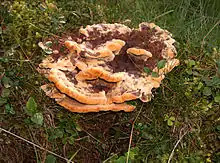| Phaeolus schweinitzii | |
|---|---|
 | |
| Scientific classification | |
| Kingdom: | |
| Division: | |
| Class: | |
| Order: | |
| Family: | |
| Genus: | |
| Species: | P. schweinitzii |
| Binomial name | |
| Phaeolus schweinitzii | |
| Phaeolus schweinitzii | |
|---|---|
| Pores on hymenium | |
| Cap is offset | |
| Hymenium is decurrent | |
| Stipe is bare | |
| Spore print is white to yellow | |
| Ecology is saprotrophic or parasitic | |
| Edibility is inedible | |
Phaeolus schweinitzii, commonly known as velvet-top fungus, dyer's polypore, dyer's mazegill, or pine dye polypore, is a fungal plant pathogen that causes butt rot on conifers such as Douglas-fir, spruce, fir, hemlock, pine, and larch.[1] P. schweinitzii is a polypore, although unlike bracket fungi the fruiting body may appear terrestrial when growing from the roots or base of the host tree.[2]
The fruiting bodies, appearing in late summer or fall, commonly incorporate blades of grass, twigs, or fallen pine needles as they grow.[3] They are tannish with darker brown centres, with orange to pale margins on young specimens.[2][4] They may grow beyond 25 cm in diameter.[4] As the fruiting bodies age, the pore surface turns from yellow to greenish yellow, the top becomes darker, and the yellow-brown flesh becomes harder and more wood-like.[3] The pores bruise brown.[2] The spores are white, elliptical, smooth, and inamyloid.[4]
The effect, impact and significance of infection by this fungus is rooted in the fact that it causes brown rot, which degrades the cellulose. Thus there is a loss of tensile strength which often leads to brittle fracture near the stem base, even at a fairly early stage of decay. Decay initiated above ground can lead to branch snap or breakout.[5]
P. schweinitzii is native to North America and Eurasia,[1] and has been identified as an exotic species in New Zealand, Australia, and South Africa.[6] It is not edible.[7]
As its common name suggests, the dyer's polypore is an excellent natural source of green, yellow, gold, or brown dye, depending on the material dyed and the mordant used.[3][8]
P. schweinitzii is named after Lewis David de Schweinitz, a Pennsylvania-born Moravian minister and important early American mycologist.
Similar species include Heterobasidion irregulare, H. occidentale, Inonotus dryophilus, and Onnia tomentosa.[4]
References
- 1 2 Hagle, Susan K.; Filip, Gregory M. (March 2010). "Schweinitzii Root and Butt Rot of Western Conifers" (PDF). Forest Insect & Disease Leaflet. USDA Forest Service (177).
- 1 2 3 Trudell, Steve; Ammirati, Joe (2009). Mushrooms of the Pacific Northwest. Timber Press Field Guides. Portland, OR: Timber Press. p. 262. ISBN 978-0-88192-935-5.
- 1 2 3 Volk, Tom; Hanmer, Debby (November 2007). "Phaeolus schweinitzii, the dye polypore or velvet-top fungus". Tom Volk's Fungus of the Month. Retrieved 2011-01-14.
- 1 2 3 4 Davis, R. Michael; Sommer, Robert; Menge, John A. (2012). Field Guide to Mushrooms of Western North America. Berkeley: University of California Press. pp. 351–352. ISBN 978-0-520-95360-4. OCLC 797915861.
- ↑ Watson, Guy; Green, Ted (2011). Fungi on Trees. Gloucestershire, England: The Arboricultural Association. p. 46. ISBN 978-0-900978-55-5.
- ↑ "Exotic Wood Decay Fungus on Pine". Forest Health News. Scion (126). February 2003.
- ↑ Phillips, Roger (2010). Mushrooms and Other Fungi of North America. Buffalo, NY: Firefly Books. p. 304. ISBN 978-1-55407-651-2.
- ↑ "Dyeing with Mushrooms". Mushroom-Collecting.com. Retrieved 2009-10-26.